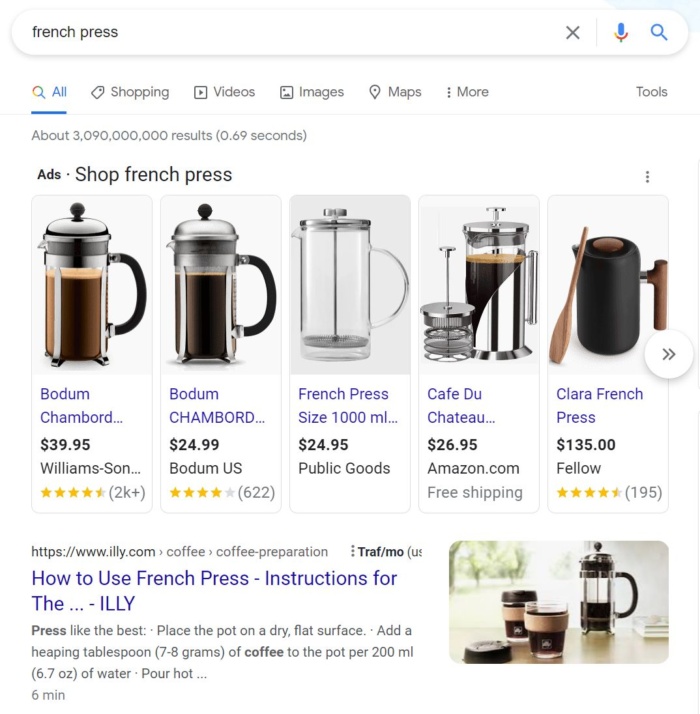
These two concepts are among the most significant in the digital sphere, but what distinguishes them from one another? As you might have guessed, SEO and SEM have the same “SE” part. This SE category encompasses everything that has to do with search engines (SE), including traffic quality and quantity of the 3.5 billion searches conducted on Google every day.
Both sponsored and organic search results are included in Google search results. While Search Engine Marketing (SEM) uses various paid search ads to draw visitors, Search Engine Optimization (SEO) draws traffic naturally. Although the debate between SEO and SEM in the field of digital marketing can be perplexing.
What Exactly Is SEO?
The O stands for optimization in SEO. The practice of improving a website’s or other online content’s ranking for prominent search results on Google is known as SEO, or search engine optimization.
The main distinction between SEO and SEM is that online content needs to be optimized in order to rank higher on Google naturally. Consider it this way: if someone searched for “glazed donuts,” they were probably looking for a bakery, ingredients, or a recipe.


By using such a strategy, you can outrank other websites without having to buy advertising.
Additionally, there are 3 techniques to split down SEO to increase traffic:
- On-page
- Off-page
- Technical
Before you can begin to get your content to rank higher, it is imperative that you have a thorough understanding of how search engines work. This is how you create the framework for an effective long-term SEO plan.
Our main objective is to teach you how to improve your content so that it ranks higher on Google and draws more visitors to your blogs and web sites.
Technical SEO, On-Page SEO, and Off-Page SEO
These three major routes make up the fundamental components of SEO:
In simple words, creating on-page content to improve your ranking is on-page SEO. It all boils down to writing high-quality material frequently, incorporating keywords into your on-page content, and ensuring that your metadata is written efficiently.
Off-page SEO improves areas of your website such as constructing backlinks. This component of the SEO formula is necessary for developing connections and creating content that people want to share. Although it takes a lot of work, it is essential to your SEO performance.
Technical SEO, as the name implies, focuses on optimizing non-content-related elements of a website. This would include your site’s structured data, crawlability, speed, and mobile friendliness, to mention a few examples.
After addressing the question “What is SEO?,” let’s examine the definition of SEM.
What does SEM mean?
SEM has the M in marketing. SEM, to put it simply, is SEO that costs money. SEM encompasses a variety of paid search advertising models. The budget that pays for the ad must be related to a user’s search query when using sponsored search tactics like pay-per-click (PPC) to boost visibility in the SERPs.
What is PPC, then? You, the advertiser, get charged a fee each time someone clicks on your advertisement. In essence, your goal is to draw customers who are looking for your brand’s products, services, or information as a solution. You’ll create leads, boost sales, and raise brand exposure using the PPC sponsored search strategy.
This is the sort of stuff that typically sits at the top of a list of pages and appears as a Google advertisement. It usually has to do with where and how you employ your keywords, which emphasizes the significance of having a clear plan and strategy in place. SEM is efficient regardless of the budget size. These keywords are then shown next to the searcher’s results as an advertisement.
There are several formats for these advertisements, including:
- Ads in text

- Visual advertisements, such as product listing or shopping ads (PDLs)

The main advantage of SEM is that it enables you to market your products to potential clients who are looking to you to meet their demands.
SEM vs SEO
Let’s keep it simple: SEM links to sponsored search, whereas SEO links to organic search. Your website’s or pages’ SEO optimization informs Google that your content is the optimal place for a user’s search. You have a better chance of obtaining high-quality traffic and increased conversions once your site is SEO-friendly.
A paid technique to achieve this presence on search engines is SEM vs. SEO. PPC advertisements assist in reaching your target market and boosting conversions and return visitors. SEM is the best option if you want to start generating clicks and conversions right away. After testing your paid advertisement, you can make changes and confirm that the traffic flow you want is occurring. They cannot be used interchangeably. They can cooperate to target audiences through search engines like Bing or Google, though.
How Do SEO and SEM Work Together?
Although they may sound like they do the same thing, the two are essentially different strategies for appearing higher on the SERPs. The purpose of both SEO and SEM when discussing how they work in conjunction with one another is to make content more visible. By optimizing for keywords that target your audience and niche, you may increase and improve the visibility of your website and appear higher in the SERPs. To determine which approach to employ when speaking to your target audience, test both terms.
Driving relevant traffic to your website is the main goal of both SEO and SEM. Both organic and sponsored approaches can be used to create the flow that results from both strategies. With the help of the data feedback from these techniques, you’ll learn more about your audience. You must have a thorough understanding of your target audience in order to develop an efficient plan for SEM or SEO.
Conduct keyword research to discover and target keywords for SEO and SEM. You can stay up with the competition more easily if you are aware of their tactics in addition to your audience’s. You can dominate the SERPs and ensure that you are seen in both paid advertisements and organic ranks by combining the forces of SEO and SEM.
When is it better to use SEO than SEM?
Knowing what’s best for your search marketing strategy will help you decide when to prioritize SEO vs. SEM in your digital marketing initiatives. SEO will be more sensible if you have a tight budget. If you can only keep your ad up for a week, you won’t get the SEM results you want. In actuality, you’ll be wasting your money instead of developing a long-term strategy.
SEO will start working if you can wait. Your keywords must be on par with your high-quality content if you’re publishing it. This is important for Google ranking. If you take ranking seriously, you can explore link-building tactics. By doing this, you may make SEO work in your favor and build up your page authority.
When is SEM better than SEO to use?
If you look closely into SEM, you’ll see that testing and launching pages will show you which method works the best. Once you get going, you’ll understand why practice and testing are necessary. Maintaining organization with a monthly budget will help you identify what works and what doesn’t.
Your results will vary depending on factors like ad wording, keyword combinations, and landing pages. To maximize the return on your advertising spending, process all the data. If you have these things in order, SEM can actually be beneficial because it functions faster than SEO. In this manner, you may use the paid SEM benefits to outperform or outbid competitors for advertising that would attract potential consumers.
In either case, a set-it-and-forget-it approach will not work for SEO and SEM. Each strategy needs to be continually reviewed, evaluated, and modified if it is to be effective.
Conclusion
Which one will you select to grow after learning the distinctions between SEO and SEM? The value of your website will unquestionably increase with time. SEM is the preferable option, though, if you want to enhance your traffic quickly and go up the SERPs.
But keep in mind that you can benefit from both. Within your search marketing plan, SEO will be one of your non-paid techniques, and SEM, including PPC, will be your paid tactics. Avoid missing out on the advantages of employing both by avoiding the SEO vs. SEM debate. While each of these has benefits and drawbacks on its own, when combined, they can provide you a significant competitive advantage.
